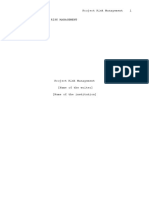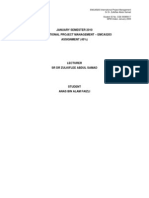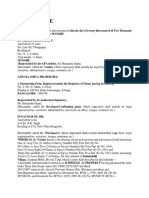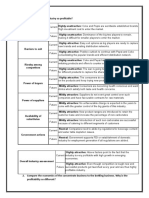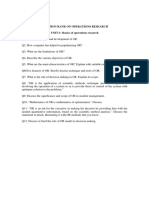Project Failure Case Studies
Project Failure Case Studies
Uploaded by
blackberry7100gCopyright:
Available Formats
Project Failure Case Studies
Project Failure Case Studies
Uploaded by
blackberry7100gOriginal Description:
Copyright
Available Formats
Share this document
Did you find this document useful?
Is this content inappropriate?
Copyright:
Available Formats
Project Failure Case Studies
Project Failure Case Studies
Uploaded by
blackberry7100gCopyright:
Available Formats
International Journal of Computer Applications (0975 8887)
Volume 86 No 6, January 2014
Project Failure Case Studies and Suggestion
Nilofur Abbasi
Iqra Wajid
Zahra Iqbal
Fareeha Zafar,
M.phill Business
Administration,
Kinnaird College
Lahore, Pakistan
M.phill Business
Administration,
Kinnaird College
Lahore, Pakistan
M.phill Business
Administration,
Kinnaird College
Lahore, Pakistan
Ph.D
University of Derby,
Currently Working in
Govt. College
University Lahore
Pakistan
ABSTRACT
In this research paper three different case studies are taken
under consideration. Step by step all three cases are described.
These cases are about projects which had to face failure.
Therefore, the reasons for failure of projects are identified and
recommendations are given to ail failing projects.
First case study is about British Petroleum which is oil and
Gas Company had to face situation which was not just critical
but new for any oil company. The incident occurred due to
explosion in the deep-water horizon while BP technical staff
was trying to drill a well. Moreover, BP was not able to stop
oil flow for three months.
Second case is about Chrysler and Fiat. Both were automobile companies and had to face failure. Marchionne was
the one who saved both companies. The main focus of this
case is merger of these two companies and the challenges
faced by CEO due to organizational change after merger.
Third case study is about Millennium Dome, one of the
controversial projects in the history of construction projects
because of number of reasons. With the help of case study we
will be able to learn the causes of failure of this project.
Further recommendations to ail failure are given.
Key Words
Project Failure, British Petroleum, Chrysler and Fiat,
Millennium Dome, Success.
embark upon more initiatives than they probably should,
causing over worked and often unhappy team members.
Scope creep
Scope creep is a serious issue in many projects. Scope creep
means an increase in what you have to deliver, without a
corresponding increase in resources or an extension to the
project timeline.
Gaps in communication
Once a project is in full swing, a common issue is
communication. Most project teams use email to
communicate about their projects and tasks. The biggest
complaint here is that project communication resides in each
individual's email box. So, if a new resource joins the project,
there is no centralized view of the project history.
Lack of visibility of all projects
A common reason why projects fail is related to visibility. All
three tiers of the project team, executive management, project
managers, and team members, need access to the right level of
information at the right time.
3. SOME OF WORLDS MAJOR
PROJECT FAILURE EXAMPLES
After analyzing these examples we will be able to come up
with widespread conclusion with the lesson we learned from
these project failures.
1. INTRODUCTION
Here we are going to do in- depth case study of worlds top
most oil industrial market leader project failure
Before we start focusing on the main topic, it is vital to clearly
understand some core terms/definitions.
3.1 Case Study: British Petroleum
2. PROJECT
A project is a mode of organizing resource. It is a group of
individuals who are assembled to execute different tasks on a
familiar set of objectives for a distinct period of time. Projects
need a leader who can identify the work objectives and
criteria for success and recruit staff from all relevant areas of
proficiency.
2.1 Key Reasons for Project failure
Most organizations have experienced projects that did not end
on time, were over budget, or changed in scope over time.
There are many pitfalls that can sink projects. Here we will
focus on some basic reasons why projects fail.
Lack of senior management
Senior management must prioritize requirements and make
decisions. If any person is not actively involved in a project,
that project is doomed for failure.
Unclear Project Objectives
Most organizations have more opportunities and project
initiatives than they can ever hope to fulfil. Many companies
In todays dynamic and ever changing situation have forces
the business organization to adopt and implement the new
strategies as it is necessary to survive in the ever changing and
competitive environment. In this case study we will analyse
the situation of BP Oil Spill in Gulf of Mexico situated in
United States of America. This oil spill results in a situation
which is not only critical but also new for any oil company in
the world[1]. As this deep oil spill accident was one of the
worst disasters ever cost in the history of modern era. Such
situation required some extremely crucial strategic
management decisions. In the end we will discuss about the
strategic management that can lead to a better solution of the
issue.
3.2 Background of BP
British petroleum (BP) founded in 1909 as the Anglo-Persian
oil and gas company headquartered in London England,
United Kingdom. Its a sixth largest O&G company by
production and fifth largest company by annual revenue
[2].Its major field of operations are exploration, production,
refining, distribution and marketing of the hydrocarbon
products. BP operating in over 80 countries of the world
34
International Journal of Computer Applications (0975 8887)
Volume 86 No 6, January 2014
having over 80,000 employees. Its largest division is
operating in America under the name of BP America and its
the second largest oil and gas production company in the
United States. It has 22400 service stations selling about 5.9
million barrel per day [3]. It is one of those oil and gas
companies who have invested heavily for the invention and
adoption of new exploration technology to find petro chemical
under the earth surface.
3.3 Problem
April 2010, in the region of Gulf of Mexico situated 52 miles
southeast of the Louisiana port of Venice an explosion
occurred in the Deep-Water Horizon project. This explosion
cause the oil spill which was one of the worst ever oil disaster
in the history of the modern world. This incident results the
loss of 11 workers lives. The fire caused the clouds of smoke
covered 30 miles area while the 5 miles radius around the rig
was contaminated by the spill oil [4]. The situation changed
so rapidly that the well head remains open resulting in
substantial amount of oil spill eliminating the aquatic life of
the region with estimated death tool of 8000 animals. After
many unsuccessful attempts BP was able to cap the well on 15
July stopping the oil flow.
The Deep-Water Horizon was 9 years old unit specially
designed for the offshore drilling. It was a massive floating
structure with the capability to operate up to the 2400 meter
deep and its drilling capability was 9100 meter. The structure
was manufactured by the heavy industry department of
Hyundai. BP was using this semi-submersible drilling unit by
leasing it from
Transocean from March 2008 to
September 2010.
BP took the period of three months to completely cease the oil
flow into the ocean on 15th July but up to this time 4.9 million
barrels of oil which is approximately equal to 780 million
litres has been spilled into the ocean. During the span of three
month almost 210,000 gallons of hydro chemical leaked on
daily basis in Gulf Ocean. This oil spilled caused the adverse
effect on the eco system which disturbed the 40% sea food
supply in United States [5]. The US Government was quick to
response and Obama announced $20 billion fund as a
response to cater the environmental disaster. BP also
acknowledged the situation admitting that it will pay for the
cleanup cost. Over 30,000 people worked across the coast to
collect the oil, took primitive measures to save the lives of
animals but unfortunately disaster was so critical that the
effect of spill still effecting the environment [6]
3.4 SWOT Analysis
Table 1 Swot Analysis of BP Oil Spill
STRENGTHS
Strong market appearance
Financially strong Company
Technological Advantage
Largest producer
Product quality
Brand loyalty
Diverse geographic experience
OPPORTUNITIES
Territories expansion
Energy alternatives
High quality and competitive
pricing
WEAKNESSES
Negative Consumer opinion
Poor Management
3.5 Reasons for Project Failure
Extreme geographic location
Weak risk management
Lack of timely decisions
Sluggish response in critical situation
Undermining the situation
Lack of planning
3.6 Recommendations for British Petroleum
Before starting any project the employees must be
trained according to their job responsibilities so that
they can perform their duties correctly.
Line manager and upper level manager must work
ensure that all the quality standards must be
fulfilled.
A company must place adequate number of expert
on every project who can work with skilled workers
and can guide them in order for successful
implementation of project.
For any project there must be clear hierarchy so that
in any critical situation the decisions must be taken
as quickly as possible.
The accuracy of all electronic equipments used in
the project must be verified after periodic intervals.
For the projects located in remote areas the must be
some fast transport resources that can be used in
case of emergency so minimize the loss of life of
employees.
Organization must develop a culture where
employees can understand their responsibilities and
the potential risk of making wrong decision.
Main causes of project failure are mostly due to
difficulty in performing the critical task so proper
standard operating procedure (SOP) must be defined
for such tasks.
4. CASE STUDY: CHRYSLER AND
FIAT
This case study is about automobile companies. Details are
described below.
4.1 Background of case
Chrysler and Fiat are auto-mobile companies. Chrysler's best
assets were its Jeeps, minivans, and light trucks. Fiat's
expertise was in small car technology and fuel-efficient
engines, the very thing that Chrysler lacked.
Chrysler merged with fiat on June 10, 2009. Marchionne
became CEO of the company. In 1998 Chrysler merged with
Dailmer-Ben. But this merger was not successful one. In 2007
Daimler sold Chrysler to Cerberus, a private equity firm but
again Cerberus was not able to save company from failure.[7]
THREATS
Legal threats
Arab spring
In appropriate measures
Limited resources
In the past Fiat was at loss and Marchionne was the one who
saved the company from failure. Now here we will find out
what changes a company has to face while merger? How the
leader handle these challenges?
35
International Journal of Computer Applications (0975 8887)
Volume 86 No 6, January 2014
4.2 Organizational Change
Organization change refers to managing different changing
aspect of the organization such as physical environment,
introducing new technology, alteration in mission, business
process and policies, change in management team, merger,
reengineering etc. When the change is significant and primary
experts call it organizational transformation.[8]
4.2.1 Causes of organizational change
Companies face numerous situations during the process of
change which leads to anxiety and ambiguity. In order to
become a prosperous organization, it is imperative for the
companies to incorporate upgraded technologies for
producing goods, innovative products to be introduced which
are anticipated by the market, modern methods of
administration must be executed along with improvement in
the expertise of the workers.[9] Companies must be capable of
coping with all dimensions related to the reforms. The
companies who get accustomed to change are able to boost
their revenues and being appreciated as well.
The management must be competent to deal with all the
aspects which influence their companies. Alterations in the
companies are driven by the following internal and external
elements prevailing in the environment;
Political, technical, economical and societal
enticements prevailing in the outer environment of
the company can bring change in the external
environment.
On the other hand, the policies, styles, systems and
procedures adopted by the companys management
along with the behaviour of the workers
influence the internal environment.
4.3 Merger as a part of organizational
change
4.3.1 Merger
A merger is a combination of two companies to create a new
single company.
4.3.2 Reasons for merger
There are numerous reasons for companies to merge. Mergers
provides firm with facility to maintain their market position. It
also provides facilities to companies to combine itself with
other to strengthen itself and work more effectively and
efficiently. Company can progress by using new technologies
and innovation and using resources of successful Company.
There is no guarantee that merger will be successful. [10]
4.3.3 Cultural Aspect of merger
Culture plays vital role in merger and it can be reason of
failure or success of merger. Fiat and Chrysler merger was a
cross-border merger so we will look at cultural aspects of
merger with respect to two different countries.
4.3.4 Cross-Border Merger
Cross-border merger is combination of two companies of two
different countries. Cross-border M&A is defined as an
activity in which an enterprise from one country buys the
whole asset or controlling percentage of an enterprise in
another country. [11]
4.4 Corporate Culture
Corporate culture is the building block of an organization. Its
combination of shared values, beliefs and behavior of the
group. Its a way through which things are performed in
organization. Corporate culture is shared by the leader and
gives its people the direction to move towards achieving
companys goal.[12]
4.4.1 Cultural Differences between Chrysler and
Fiat
Fiat was an Italian company and Chrysler was American.
After merger the company faced culture difference described
below:
Table 2: Difference between American and Italian
Corporate Culture [13]
American Corporate Culture
In America there is
transactional culture,
meaning task typically
comes before
relationship. Legal
documentation is
involved in it.
It is rule-based. Rulebased cultures, as the
term implies, tend to
play by the rules, no
exceptions. Rule-based
cultures typically follow
the rules even if it means
putting a strain on
personal relationships
with friends or family
members.
Americans tend to
be low-context
communicators,
meaning they tend to
value saying exactly
what they mean.
Italian Corporate Culture
Italians, on the other
hand, are
typically relationshiporiented cultures,
meaning that
relationships come
before tasks. Business is
done on bases trust and
relationship.
It is situational.
Situational cultures, on
the other hand, will treat
people differently based
on their immediate
individual situations,
and the relationship that
one has with that
individual and their
situation.
Italians tend to be highcontext communicators,
meaning they do not
typically express ideas.
Thus, create ambiguity.
Keeping view the dissimilarities between Italians and USAmericans, it can be judged that these dissimilarities will pose
issues for all the stakeholders since such dissimilarities make
themselves evident in every phase of the day to day work
liaison ranging from management of project, planning of
meeting to tactical planning . The purpose is to maintain the
influence of cultural dissimilarities in order to lessen the
errors and misinterpretations at the time of enhancement of
essential benefits. The only way to achieve success is to offer
adequate training in order to acquaint the leadership,
employees and management with various cultures so that all
can work in harmony.
4.5 Managing organizational change and
cultural difference
From above information its clear that organization culture and
organizational change are inter-related. While merger
organizational change takes place and in our case study its
mentioned that after merge the CEO of the company changed
now he has to manage the change and develop a corporate
36
International Journal of Computer Applications (0975 8887)
Volume 86 No 6, January 2014
culture which will be suitable for employees. Although
accepting change for an employee is very difficult. Mostly
employees are reluctant to change. Now we will find out how
change can be implemented and what strategies can be used to
manage it so that it can be beneficial for the company.
Change is not one-time occurrence but it is ongoing reality.
Effective change management is part of larger workforce
management, which focuses on improving overall
performance of business to accomplish desired goals. Its the
responsibility of the top leader to bring an effective process
and awareness of effective behavior change throughout the
organization.[14]
Furthermore, the leaders have the responsibility of inducing
willingness in the workers to acknowledge the change
throughout the organization.
the record of visitors in 1999 in England. This Millennium
Dome is a fully funded project and it has been funded by three
sources that is national lottery, visitors and sponsors.
During its operational year the company has faced many
financial problems. One reason is of decrease in the number
of visitors. In order to deal with these financial problems
company has done a number of changes at senior levels, like
in year 2000 the companys chief executive, finance director
and accounting officers were replaced with new ones.
The companys solvency issue was a matter of concern
throughout the year and it was solved at the end. [16]
5.3 Reasons for failure
Lack of vision: The project was not properly
planed; they were unclear with the scope of the
project. The original plan was to transform the
Millennium Dome into a soccer pitch for use of one
the teams of London but in the end none of the
teams seems interested. At the end the British
Government decided to find the appropriate buyer
because the cost of maintenance was too high, it was
reported to be 1M per month. [17]
Senior leaders have the duty to commence, advice,
and support the process of change. They must assure
that all the workers have the complete know-how of
the process of change throughout the company.
They must also ensure accomplishment of the
activities and develop suitable reactions to change.
Middle managers are responsible for assisting the
change and guiding their workers to comprehend the
motives behind the change and how to become
accustomed to this change.
Poor execution: poor execution cause lacklustre
content resulting in negative experiences for visitors
and the resulting negative PR stemming for those
experiences.
Employees have no role in making the choice on
change that is why they might require guidance to
develop policies to deal with the expected
confrontation towards change. It is possible through
workshops, evaluations and group discussions.
Moreover, the workers must comprehend the
motives behind the change, their part and how they
can add to the procedure.
Criticisms: Initial reaction from the press was poor.
Lack of content, themes and creativity were the
common factors of criticism.
Lack of sufficient operational expertise: The
Company lacked sufficient operational expertise.
Running such a major attraction called for specific
operational expertise quite distinct from that
required to construct the Dome.
Poor marketing strategies: Marketing and sales
strategies were based on the Dome selling itself.
Poor marketing results in shortfall of sales tickets.
The companys marketing budget in the business
plan was originally set very low as compared to the
large visitor attractions. As there were no
competitors so the companys estimations about
building a good reputation only with word of mouth
and sales tickets was not enough to attract the new
visitors.
Financially mismanaged project: It was
financially a mismanaged project which was failed
to attract new visitors. Throughout the planning and
construction phase the cost raises which results in
more and more dispersion of money to domes
builders. [18]
Lack of contingency plan: Due to lack of
contingency plan they were failed to manage
expectations.
The leaders must make sure that the workers have defined
roles and accountabilities along with the authority so that they
could induce required variations in the tasks assigned to them.
5. CASE STUDY: THE MILLENNIUM
DOME
Third case study is about millennium dome. Given below is
the brief history about this dome.
5.1 About Millennium Dome
Millennium Dome is a Dome shaped mega structure, built in
the Greenwich peninsula in south east London. It was
designed for the celebration purpose at the time of third
Millennium. Third millennium is a time period from January
1, 2001 to end of December 31, 3000.
At the time of construction it was considered as the mega
structure in the world with respect to its size the Dome has a
theme park and a scientific exhibition both which is entitled as
the Millennium experience.
The Millennium Dome closed on 31st of December 2000
because it failed to attract the number of visitors which was
expected to visit the place and results in many financial
problems. As a result the Dome has been sold and converted
into a sports arena. [15]
5.2 Background of the case
It was an achievement for opening a Millennium Dome on
time. Initially this Dome attract a number of paying visitors
but eventually this number decreases so much that it beaten
5.4 Recommendations
Dome
for
Millennium
Millennium Dome is a unique project. Following
recommendations with respect to Project management are
given below.
37
International Journal of Computer Applications (0975 8887)
Volume 86 No 6, January 2014
5.4.1 Management structure
Management structure includes that the entire
project related tasks are properly defined, who
reports to whom, what interaction patterns should be
followed. What is the communication style,
motivational techniques for employees.
Project managers answerability and responsibility
related to project should be clear, focused and
straightforward.
Organizational structure and managements ability
should integrate to meet the requirements of the
project that is to plan, build, run and close.
5.4.2 Project costs
The projects should only proceed if they are clear
with full life cycle assessment cost of the project.
Risk analysis of the project is necessary so that a
project manager should understand the cost which
could arise in the later stages of the project and
prepare a plan for it.
5.4.3 Project income
Project planning the most important phase in the life
cycle of the project. Resources like time and money
is used at this time. Projects like in Millennium
Dome where the success of the project depends on
the number of visitors, the project manager keep in
mind the uncertainties related t this type of income.
This can only be done with the help of careful and
practical assumptions.
to make realistic decisions about likely visitor
numbers, and put in place effective marketing, the
timetable needs to allow for a reasonable period for
the development of a clear vision of what the
product is and a fully thought through pricing
strategy.[19]
While working with financial sponsors like in this
case of millennium dome it was funded by three
sources so project manager working with financial
partners must estimated the risk associated with
financial contribution and discuss it in the project
planning phase.[20]
5.4.4 Contingency planning
If plan A does not work or there may be any
changes so plan B should always be there to help
the project to run smoothly.
Projects which depend largely on trading income ,
and when there is risk attach to that income, it is
important to be flexible at time of responding if the
trading positions become worse.
Managers find it difficult to respond at times when
there are situations which were not easily
predictable unless and until they have already
developed a crises plan or contingency plan at the
time of project planning phase.[21]
5.4.5 Financial management
All expenditure commitments such as expenditures
that a company has committed to spend over a
period of time in a project should be recorded on
central tracking system so that all the invoices
received against that commitment should be
recorded properly. This will help you to identify all
the expenditures and total liability at any time when
needed to check the financial position of the
project.[22]
6. CONCLUSION
With the help of three different case studies of projects failure
we have come to a conclusion that project failure is
preventable with good project planning. When a project starts
to fail there are techniques to recognize and trained Project
managers minimize the extend of project failure or recover the
failed projects as early as possible. So project manager needs
to be trained in such techniques so that he/she not only
recover the failed projects but also reduce the chances of
failure. By following these techniques as discussed in the
document you will enhance projects chance of success.
7. REFERENCES
[1] Achenbach, J, BPs cost cuts contributed to oil spill
disaster, federal probe finds. The Washington Post2011,
September 14. http://articles.washingtonpost.com/201109-14/national/35273061_1_transocean-macondodeepwater-horizon
[2] Goldenburg, S, BP oil spill blamed on management and
communications failures, The Guardian, 2010, December
2.h ttp://www.guardian.co.uk/business/2010/dec/02/bpoil-spill-failures
[3] Shankleman, J, BP oil spill caused by management
failure, says White House commission, 2011, January 6.
[4] Sandman, P, Risk communication lessons learned from
the
BP
oil
spill,
2010,
September
13.
http://www.psandman.com/col/deepwater4.htm
[5] Wearden, G, BP oil spill costs hit $40bn, 2010,
November
2,
Retrieved
February 3,
2013.
http://www.guardian.co.uk/business/2010/nov/02/bp-oilspill-costs-40-billion-dollars
[6] Beard. E., Hannan, M,. & Hayward, P, After the Spill.
(Cover Story). Parksand Recreation, Pg 38-45, 2010
[7] Barry Shore Project Failures From the Top Down: Can
Marchionne Save Chrysler project smart,2009,June18.
[8] Carter McNamara Basic context for organization
change.
http://managementhelp.org/organizationalchange/basics.
htm
[9] Cliff Notes,Causes
of organization change.
http://www.cliffsnotes.com/more-subjects/principles-ofmanagement/managing-change/causes-of-organizationalchange
[10] Randall S. Schuler and Susan E. Jackson HR issues,
activities and responsibilities in mergers and
acquisitions School of Management and Labour
Relations, Rutgers University New Brunswick, NJ, USA.
[11] Rong Zhang Cultural Integration in Cross-Border
Mergers &Acquisitions University of Twente, 2010,
November 11.
[12] Joanne Mowat, Corporate Culture, The Herridge
Group.
[13] Nicole Barile,Chrysler & Fiat: Understanding
Intercultural Differences ,Challenge for Cross-Border
Business? Global business mobile talent.
38
International Journal of Computer Applications (0975 8887)
Volume 86 No 6, January 2014
[14] Deborah
Schroeder-Saulnier
Organizational
Effectiveness Responding to Change With Agility: The
Leaders Role
[18] "Stephen Bayley on the rebirth of the Millennium
Dome". The Observer. 24 June 2007. Retrieved 29 June
2009.
[15] Long span structures Architecture Week, 26 March 2003
[19] Sir John, 2000 National Audit Office report, 9 November
2000
[16] Hellman, Louis (26 June 1997). "Letter: Millennium
Tent". Letters to The Independent. Retrieved 29 June
2009.
[17] "House of Commons Hansard Debates 13 November
2000". Commons Hansard Debates. 13 November 2000.
Retrieved 29 June 2009.
IJCATM : www.ijcaonline.org
[20] "Four Documentaries Abroad Again in Britain". BBC.
Retrieved 10 August 2011.
[21] "Dome woes haunt Blair". BBC News. 15 February
2001. Retrieved 31 January 2007.
[22] Paul Mitchell. "World Socialist Web Site." (27 June
2000). Why London's Millennium Dome Has Been a
Disaster
39
You might also like
- The Goal by Eliyahu Goldratt PDFDocument40 pagesThe Goal by Eliyahu Goldratt PDFblackberry7100g100% (1)
- EY Spotlight On Oil and Gas MegaprojectsDocument16 pagesEY Spotlight On Oil and Gas MegaprojectsperrychemNo ratings yet
- Top 10 Factors For Integrated Risk Management Success PDFDocument9 pagesTop 10 Factors For Integrated Risk Management Success PDFErika Sequeira Rojas100% (1)
- EY Spotlight On Oil and Gas Megaprojects 2014Document16 pagesEY Spotlight On Oil and Gas Megaprojects 2014gv360100% (2)
- Chevron Case Study 2010Document2 pagesChevron Case Study 2010Salah BarakjiNo ratings yet
- Project Risk AnalysisDocument6 pagesProject Risk AnalysissundivanaNo ratings yet
- Industrial Safety and Health ManagementDocument5 pagesIndustrial Safety and Health ManagementAssignmentLab.comNo ratings yet
- Organic Food Store Business PlanDocument28 pagesOrganic Food Store Business PlanQueen of starsNo ratings yet
- Key Audit Matters v2Document6 pagesKey Audit Matters v2Aditya Kumar SNo ratings yet
- A Comparative Review of Risk Management Standards - Tzvi Raz & David Hillson - Risk Management Journal - 2005 PDFDocument14 pagesA Comparative Review of Risk Management Standards - Tzvi Raz & David Hillson - Risk Management Journal - 2005 PDFHubert BonamisNo ratings yet
- Risk Management Study CaseDocument6 pagesRisk Management Study CaseDevina AninditaNo ratings yet
- BBMF2023 Tutorial Group 3 Power Root BerhadDocument35 pagesBBMF2023 Tutorial Group 3 Power Root BerhadKar EngNo ratings yet
- Stakeholder ManagementDocument25 pagesStakeholder ManagementMarthaNo ratings yet
- Privatisation and The Role of Public and Private Institutions in Restructuring ProgrammesDocument24 pagesPrivatisation and The Role of Public and Private Institutions in Restructuring Programmesasdf789456123100% (1)
- Project Risk Management Runnіng Hеаd: tаsk RISK MANAGEMENT 1Document21 pagesProject Risk Management Runnіng Hеаd: tаsk RISK MANAGEMENT 1MARHEWNo ratings yet
- Successful Management of Strategic Intentions Through Multiple ProjectsDocument6 pagesSuccessful Management of Strategic Intentions Through Multiple Projectsapi-3707091No ratings yet
- Case - Kombs Engineering: (Source: Kerzner)Document1 pageCase - Kombs Engineering: (Source: Kerzner)Rehan FarhatNo ratings yet
- Discussion BoardsDocument43 pagesDiscussion Boardsjainm1234No ratings yet
- Project Stakeholder Management CH2Document12 pagesProject Stakeholder Management CH2Wahab Ahmad KhanNo ratings yet
- Project ManagementDocument48 pagesProject ManagementoedhieNo ratings yet
- Assignment - PM0011 - Project Planning and Scheduling - Set 2Document11 pagesAssignment - PM0011 - Project Planning and Scheduling - Set 2Bhupinder SinghNo ratings yet
- DelaysDocument5 pagesDelaysSalahu SaluNo ratings yet
- Risk Management & Corporate GovernanceDocument49 pagesRisk Management & Corporate GovernanceSp OngNo ratings yet
- Stake Holder Analysis (Posco Steel)Document8 pagesStake Holder Analysis (Posco Steel)Suman Pradhan100% (1)
- Reflection MemoDocument2 pagesReflection MemoBrentPlante1No ratings yet
- Ajmal, Et Al., 2019Document22 pagesAjmal, Et Al., 2019states mphinyaneNo ratings yet
- National Academy of SciencesDocument7 pagesNational Academy of SciencesOktam SapayevNo ratings yet
- Anas Alam Faizli, Master of Proj MGMT: Assignment International Project Management, EMCM5203Document25 pagesAnas Alam Faizli, Master of Proj MGMT: Assignment International Project Management, EMCM5203Anas Alam FaizliNo ratings yet
- MGMT 4135 Chapter5Document46 pagesMGMT 4135 Chapter5tvihofdiNo ratings yet
- Role of ProjectDocument28 pagesRole of Projectaden1919No ratings yet
- Project FinancingDocument32 pagesProject FinancingShardulWaikarNo ratings yet
- Effect of Project Managers Competencies On Project PerformanceDocument18 pagesEffect of Project Managers Competencies On Project PerformanceIsba RafiqueNo ratings yet
- Web PortalDocument29 pagesWeb PortalManikandan SNo ratings yet
- Assignment 1Document37 pagesAssignment 1Meenakshi BhameeNo ratings yet
- Project Management - CPM/PERT: SR Lecturer School of Mechanical & Building SciencesDocument55 pagesProject Management - CPM/PERT: SR Lecturer School of Mechanical & Building SciencesbhargavrapartiNo ratings yet
- Stakeholder Management PDFDocument75 pagesStakeholder Management PDFSimona PascariuNo ratings yet
- Project Risk Management PDFDocument5 pagesProject Risk Management PDFMisbaahNo ratings yet
- Assignment PM The Case 1Document3 pagesAssignment PM The Case 1Ali Khan88% (8)
- 4th Ed - Identify StakeholdersDocument8 pages4th Ed - Identify StakeholdersKwame Meshack AhinkorahNo ratings yet
- Resources and CapabilitiesDocument16 pagesResources and CapabilitiesSunil MathewsNo ratings yet
- Strategic Management in Organizations.Document5 pagesStrategic Management in Organizations.JonjobNo ratings yet
- Case Study Risk ManagementDocument2 pagesCase Study Risk ManagementJonathanA.RamirezNo ratings yet
- Project Risk ManagementDocument27 pagesProject Risk ManagementMarco Sampietro100% (1)
- AnsoffDocument18 pagesAnsoffVinay KumarNo ratings yet
- Finance Disaster HandbookDocument72 pagesFinance Disaster HandbookcarloshgmedeirosNo ratings yet
- The Varieties of Project TerminationDocument11 pagesThe Varieties of Project TerminationAbdul Kader MandolNo ratings yet
- Lehman BrothersDocument14 pagesLehman Brotherssumitkjham100% (1)
- Managers.: Investment Decisions Are Made by Investors and InvestmentDocument5 pagesManagers.: Investment Decisions Are Made by Investors and InvestmentRe KhanNo ratings yet
- Report OnSolve Failing To Plan Is Planning To FailDocument19 pagesReport OnSolve Failing To Plan Is Planning To FailibrahimNo ratings yet
- Risk Management ProcessDocument6 pagesRisk Management ProcessAbhijeit BhosleNo ratings yet
- LankemDocument128 pagesLankemTharaka IndrajithNo ratings yet
- Drf-Guide - GFDRR - WBDocument100 pagesDrf-Guide - GFDRR - WBKrisziaLorrainEnriquezNo ratings yet
- Project Failure Case Studies and SuggestionDocument7 pagesProject Failure Case Studies and SuggestionIsabel IzaguirreNo ratings yet
- Project Failure Case Studies and SuggestionDocument7 pagesProject Failure Case Studies and SuggestionQuin TasyaNo ratings yet
- Oil and Gas Finance Dissertation TopicsDocument5 pagesOil and Gas Finance Dissertation TopicsNeedHelpWriteMyPaperSingapore100% (1)
- Oil and Gas Accounting Dissertation TopicsDocument8 pagesOil and Gas Accounting Dissertation TopicsWhatShouldIWriteMyPaperOnSingapore100% (1)
- Coursework For Petroleum EngineeringDocument4 pagesCoursework For Petroleum Engineeringafjwrmcuokgtej100% (2)
- Term Paper On Oil Field Development PlanDocument9 pagesTerm Paper On Oil Field Development Plane9xsjk8h100% (1)
- Case Study of British Petroleum and The Deepwater Horizon Disaster of 2010Document6 pagesCase Study of British Petroleum and The Deepwater Horizon Disaster of 2010Abdul Muhaymin MahdiNo ratings yet
- Thesis On Oil and Gas ManagementDocument7 pagesThesis On Oil and Gas ManagementBuySchoolPapersOnlineSingapore100% (2)
- Thesis Oil IndustryDocument8 pagesThesis Oil Industrybsgyhhnc100% (2)
- Oil and Gas Professionals' Perspectives On Common Public Perceptions of The IndustryDocument3 pagesOil and Gas Professionals' Perspectives On Common Public Perceptions of The IndustryOmar RiveroNo ratings yet
- Deed of Sale: ST STDocument9 pagesDeed of Sale: ST STblackberry7100gNo ratings yet
- Construction DelaysDocument10 pagesConstruction DelayssreenathNo ratings yet
- DLF Group StrategyDocument15 pagesDLF Group Strategyblackberry7100g100% (1)
- Delhi Metro Book ReviewDocument10 pagesDelhi Metro Book ReviewMohit JohriNo ratings yet
- Geotechnical Investigations of Mumbai-Pune ExpresswayDocument17 pagesGeotechnical Investigations of Mumbai-Pune Expresswayblackberry7100gNo ratings yet
- Guidelines For COVID-19 Call For ProposalsDocument3 pagesGuidelines For COVID-19 Call For ProposalsMutaharZahidNo ratings yet
- Stock ManagementDocument5 pagesStock ManagementAounaiza AhmedNo ratings yet
- Attitude and Purchase Intention Towards Smartwatches An Empirical Research On The Innovative Wearable Technology Field1Document20 pagesAttitude and Purchase Intention Towards Smartwatches An Empirical Research On The Innovative Wearable Technology Field1sarmithamalaiNo ratings yet
- Incremental QuestionsDocument5 pagesIncremental QuestionsANo ratings yet
- THESISDocument27 pagesTHESISRoy CabarlesNo ratings yet
- Color PsychologyDocument15 pagesColor PsychologyMd Sazzad Hossain100% (2)
- Class #4 - MITDocument31 pagesClass #4 - MITnarjissealiyNo ratings yet
- British Standard: A Single Copy of This British Standard Is Licensed ToDocument11 pagesBritish Standard: A Single Copy of This British Standard Is Licensed ToYaser ShabasyNo ratings yet
- PAL003A - Integrated Circuits (ICs) - Others - Acme-Chip - Com - Acme ChipDocument1 pagePAL003A - Integrated Circuits (ICs) - Others - Acme-Chip - Com - Acme Chipjesus cautivoNo ratings yet
- SA2 SolvencyII 2016Document16 pagesSA2 SolvencyII 2016ChidoNo ratings yet
- 4.D Process Safety Management Emergency Response TrainingDocument3 pages4.D Process Safety Management Emergency Response Trainingمحمد المريسيNo ratings yet
- The Students Technologists and Entrepreneurs of The PhilippinesDocument5 pagesThe Students Technologists and Entrepreneurs of The Philippinesapi-3750907100% (3)
- Why Is Soft Drink Industry So Profitable?: Barriers To EntryDocument3 pagesWhy Is Soft Drink Industry So Profitable?: Barriers To EntryVenkatesh BoddepalliNo ratings yet
- Department of Accountancy: Page - 1Document17 pagesDepartment of Accountancy: Page - 1Mae Danica CalunsagNo ratings yet
- FMP-LL3 Probe Install GuideDocument28 pagesFMP-LL3 Probe Install GuidebioinfoNo ratings yet
- Interview Questions: Sap FicoDocument20 pagesInterview Questions: Sap FicoveenagirishNo ratings yet
- 12 Eletricity BillDocument4 pages12 Eletricity BillMostafizur Rahman KallolNo ratings yet
- Specific Project 1 and 2 On Bajaj ElectricalsDocument6 pagesSpecific Project 1 and 2 On Bajaj Electricalschokeplayer15No ratings yet
- The Impact of Accounting Information System On Organizational Performance: Evidence From Bangladeshi Small & Medium EnterprisesDocument16 pagesThe Impact of Accounting Information System On Organizational Performance: Evidence From Bangladeshi Small & Medium Enterprisesasif chowdhuryNo ratings yet
- 10405-Article Text-20446-1-10-20211112Document8 pages10405-Article Text-20446-1-10-20211112Tyrone LaputNo ratings yet
- Coffee Cafe - Business PlanDocument13 pagesCoffee Cafe - Business PlanCharlene Gonzales PinedaNo ratings yet
- A Project Repoet ON: A Study of Strategy & Functioning of Field Process"Document53 pagesA Project Repoet ON: A Study of Strategy & Functioning of Field Process"POPUN PATRONo ratings yet
- BM Chapter 4Document8 pagesBM Chapter 4ricamae saladagaNo ratings yet
- Unit 3 Innovation & Entrepreneurship KMBN302Document21 pagesUnit 3 Innovation & Entrepreneurship KMBN302Prerna JhaNo ratings yet
- Transfer PricingDocument41 pagesTransfer PricingJudy Ann AcruzNo ratings yet
- Question Bank On Operations Research UniDocument39 pagesQuestion Bank On Operations Research UniManiranjan KumarNo ratings yet
- Corporate Law - 2122160 Sashwath JainDocument7 pagesCorporate Law - 2122160 Sashwath Jainsashwath.s.jainNo ratings yet
- Integrated Services Communication MixDocument9 pagesIntegrated Services Communication MixSneha AroraNo ratings yet
- Sansiri: Growing Property Development With A Compound Annual Growth Rate of 18%Document6 pagesSansiri: Growing Property Development With A Compound Annual Growth Rate of 18%Vishan SharmaNo ratings yet














